by Eric Wertheimer
This essay has been peer-reviewed by the boundary 2 editorial collective.
Paris is quiet and the good citizens are content.
—Napoleon Bonaparte’s first message delivered by optical telegraph after seizing power in 1799
Maybe it should not surprise us that among the first messages of consequence sent by telegraph is an exacting statement about the silent satisfaction of the “people.”[1] Contrasted with Samuel Morse’s portentously open-ended “What hath God wrought?”, the cool administrative authority of Napoleon Bonaparte’s dispatch is rendered all the more acute. A republican concern for “contentment” —the Enlightenment affection for happiness even—is condensed into a secure, omniscient, and unambiguous transmission meant for deferred public consumption. It is a mode we might call “executive”—political information traveling the secure means of public power, assuming public consent as confirmation of its administrative reach; fitting that Napoleon inherited this state technology from the republic’s ruling Directoire Exécutif (Executive Directory). The victory message encodes and relays, rather than prints and broadcasts, the certainty of order and noiselessness, presuming authority over a defined geography.
That certainty, in turn, can be understood as a product of the telegraphic process itself, a new, though not completely un-theorized, thing.[2] Prior to the telegraph, during the period of the republican nationalizing of print, a wave of information networks sought to align the aggregate of public discourse with the apparatus of state power. Napoleon’s telegraphy, however, represents a point of inflection away from this aggregation toward state power, inviting us to think about why the telegraph caused a change in republican governance. Consider that republican theories of oration and writing imagined an expansive and egalitarian field of persuasion and critique that, like a self-leveling body of water, would spread just behind, or ahead of, the nation itself. Coextensive with the information springs that diffuse its imagined selves, the new republic guaranteed a check on the balance of power between the public and civil authority. But, framed by republican ideology and the necessities of war, it became apparent during the transformations of Napoleonic statecraft that information would be both critical to public welfare and increasingly restricted within its compass. Networks of information would no longer be isomorphic with public self-conceptions—if they ever were. Republicanism’s sphere of mediation, an idealized reflecting surface, also started to become a linear network of self-locking channels—dark chambers and webs as opposed to mirrors and funnels. To be clear, telegraphy did not supplant these forms of mediation and political circuitry; rather, it added to the range of techniques available to the new republican state.
When we begin to consider the semaphoric landscape of national communications, we see the various ways the republic of letters was not so much a network of transparent arguments and narratives about national integration or even regional identity, or a stage upon which the powerful exercised their arguments anonymously in service to the public good. During the early Federal period of the 1790s, it was increasingly a republic of inverted publicity, with the relays, compressions, and decompressions of texts serving to disrupt the economic and informational systems of print, signal-making, and manuscript. And this is true not only of everyday signal-making within networked New England (cf. Matt Cohen), but also of the highest and most canonical of American Enlightenment thinkers and politicians. Understanding the technology as a transatlantic republican transfer, we can begin to understand the republic of letters in its full range of mediated symbolic economies.
*
The chambering effect of the earliest semaphore telegraphs was architecturally visible in the structure of the telegraph stations themselves, and in the patterns such structures made upon the geography of the modern national republic. Figure 1 shows a Binary Panel telegraph from 1794, which diagrammatically charges each space with discrete intelligence, at once connected to and sealed off from an integrated whole.
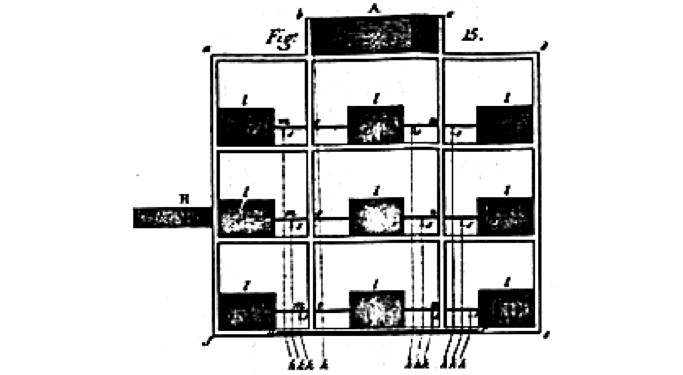
Designed as a set of relational binaries, the networked physical space combines autonomous coding with a necessary extension of that space into repeated linkages. Each linkage requires privileged access to interpretation and to the overall design of the coding structure. Individually and taken together, these stations signaled an open-air puzzle that invaded public space with private meanings about public things. Under such conditions—these coded assemblages—readers and writers form a publically private sphere, or what we might call a crypto-public.
That geometry of segmentation and networking repeated itself at larger scales. Indeed, such segmenting is evident in the regularized rhizome or web that becomes the French station map from 1792 until 1852 (see Figure 2). At the risk of over-metaphorizing the pattern, this webbed rhizome forms a networked humanoid (the King’s ghosted body?) in its telegraph system, revealing in the process a kind of early infographic of modern power.
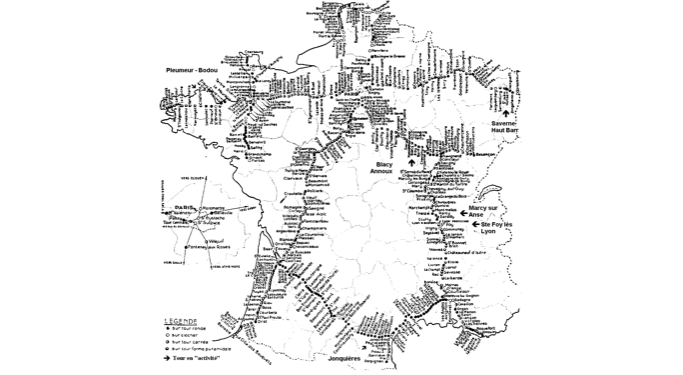
Paul Virilio has described the post-Roman segmentarity of territory as essential to the logic of modern states, imposing linearity in its militarized necessity. Perhaps that is discernible here with the return of an updated Roman militarism, very much in keeping with an echoed Napoleonic neoclassical and royal poetics, but here with the modern executive as its austere figurative counterpart. The map reveals the telos of this transformation’s capacity to make meaning visibly transportable across the French topography and adherent to the needs of the new republican executive.[3]
We can begin to evaluate this transformation, particularly visible in the 1790s, by asking questions not just of the broader shapes of networking and mediation, but of our dispositions as readers of both ambiguity and precision. The new telegraphic sphere transformed the methods of reading itself, taking the rage for cryptography and ciphers into a more systematic and pervasive (because more public and open) mode of coded transmission. Words, clauses, phrases, and sentences (which can helpfully be classified as “intelligence,” “information,” “data,” or “plaintext”) were condensed into graphemes, and then sequenced for reception that resists confusion; we might even think of it as among the earliest forms of pure information. And yet we should remember that the pure informatics of the telegraph does not exclude confusion from the structure of transmission—indeed, confusion (as with all cryptography) is a feature, not a bug. Confusion fills the role of the sealed envelope in open field communication like telegraphy, keeping the visible illegible, but packaged nonetheless. The conversion of plaintext into a smoother temporal package, able to splice distance, divides legibility into the indecipherable and the solvable. Depending on one’s access to the network of interpretive competence, one’s intention and position in the signifying relay, what appears opaque can be perfectly legible.
Telegraphy’s early binary hermeneutics had its sources in a worry about the degrading of meaning across distance and about the sufficiency of human agency itself. As a result of perceptual and interpretive decay, uncertainty emerges as an unfortunate consequence of the limitations of human acuity, a crippling nearsightedness. Telegraphy thus demanded a larger perceptual apparatus that could be prosthetically attached to the human eye, and it is given form both in the structures of the transponder stations that were built during the period of Napoleonic republicanism, and in the political state that necessitates and organizes those stations. The contingencies of visibility made signification’s emblems layered and rich, and they can be read as meaningful artifacts in both their patterns of projective mechanics and their metaphors for explaining political effects.
The quest for a secure broadcast meant rethinking the terms of internal signification, transmission and external reception—a reclassifying of the perceptual mechanics of communication. Some of that work had already been theorized as a merging of the “sudden” with the “certain.” In 1684, Robert Hooke hailed the “certainty” of a proposed telegraphic “intelligence” in a “Discourse to the Royal Society. . . shewing a Way how to communicate one’s Mind at great Distances”: “That. . . [is] a Method of discoursing at a Distance, not by Sound, but by Sight. . . . ’tis possible to convey Intelligence from any one high and eminent Place, to any other that lies in Sight of it. . . in as short a Time almost, as a Man can write what he would have sent, and as suddenly to receive an Answer” (Hooke 1964, 142). Suddenness is Hooke’s word for automatism, or perhaps “telepresence.” Data imprints itself onto a computational, agent-less consciousness, forgoing faculties of judgment and interest that delay immediate understanding and make demands on memory. Distance and recall become what I would call negative fields of exchange, and only important to the degree that they are made to recede.[4] It is the origin of text as pure data rather than argumentation or even “thought”—non-conversational, foreclosing dialogue and memory, a text that is constrained and defined by its linear velocity, particularly well-suited to the purposes of the executive state. That executive state stood to recover what its nationalized representational technology might dissolve in the circuitry.
That executive reclamation, at the dawn of the constitutional era of republics, is driven by the semiotics of technological migrations and deployments. I assemble this story out of disparate fixtures that may seem wholly apart. That is, it may seem this essay is bifurcated nationally and conceptually—France and America, telegraphic structures and telegraphic metaphors—but I want to contend that the two are essential to understanding each function. While this essay is largely about French telegraphes and then American “telegraphs,” it is really about how the new world of executive informatics in the transatlantic republican era came to recognize itself as a political technology and, in so doing, made room for a new kind of communicative regime.
*
Edward Cave’s London-based Gentleman’s Magazine in 1794 ran a long item about the deployment of the semaphore telegraph in France, a piece of reportage which was reprinted in US periodicals not long after. What is particularly telling about Cave’s piece is its appending to the report a quotation from Ovid, “Fas est ab hoste doceri [It’s right to learn from one’s enemy].” Cave signals to his readers that the import of the technological breakthrough is as much in its usefulness in defining enemies as in its power as a means of communication.
Mr. Urban Sept 11.
The telegraph was originally the invention of William Amontons. . . [who] contracted such a deafness as obliged him to renounce all communications with mankind. . . . This philosopher also first pointed out a method to acquaint people at a great distance, and in a very little time, with whatever one pleased. This method was as follows: let persons be placed in several stations, at such distances from each other, that, by the help of a telescope, a man in one station may see a signal made by the next before him; he immediately repeats this signal, which is again repeated through all the intermediate stations. This, with considerable improvements, has been adopted by the French, and denominated a Telegraphe; and, from the utility of the invention, we doubt not but it will be soon introduced in this country. Fas est ab hoste doceri. (Cave 1794)
And so indeed the French enemy speaks of telegraphy as the key to republican governmentality: in this iteration, the invention is quickly attached to the purposes of a voracious political program that is, in turn, alleged to be in the service of shadowy power-hungry persons.
To Cave’s account is appended a much-reprinted copy of the notorious Jacobin Bertrand Barere’s report to the French Convention of August 15, 1794, which describes the telegraph’s value to the new Republic:
By this invention the remoteness of distances almost disappear; and all the communications of correspondence are effected with the rapidity of the twinkling of an eye. The operations of Government can be…facilitated by this contrivance, and the unity of the Republick can be the more consolidated by the speedy communication with all its parts. The greatest advantage which can be derived from this correspondence is. . . its object shall only be known to certain individuals. (Cave 1794, 815–16)
Barere’s advertisement in the English-speaking press for the new technology is decidedly political but blind to its ideological contradictions—“certain” individuals who make use of certainty, executives, seeking the unity of its dispersed publics. The telegraph is immediately conceived in such quarters in executive mode, exclusive to what Friedrich Kittler (2010) in Optical Media calls a “militant elite” (74), despite the radical democratic alignment of the partisans who are accused of deploying it.[5]
The capacity to make information a spectacular but exclusive part of modern control, and a certain kind of public comfort, was immediately evident to all who had a stake in political power. Consider the telegraph in Figure 3, which Claude and Ignace Chappe perfected as a synchronized pendulum system between 1790 and 1791.[6] Despite its anachronism as a depiction (c. 1868) it is a useful rendering of the original system as first used on March 2, 1791, with synchronized towers in Brulon and Parce. In the distance (16 kilometers) is the synced analog clock in Brulon, distinguished by the popping face of phosphorous white set on the edge of a calm green horizon.
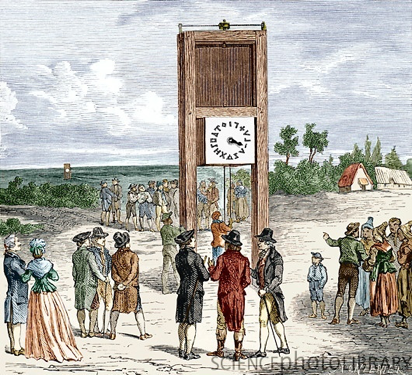
A modified clock face in guillotine-like frame is the inaugural emblem of telegraphic coding—here, divided temporality looms over all aspects of its earliest methods. More precisely, the clock face is a dead metaphor, no hands inexorably rotating through a fixed template. It has become, instead, an analogic key for the alphabet (the severed head still speaking) divided into sixteen points that indicate letters through serial combinations of position and sound. The reliance upon numerals underscores the medium’s crypto-publicity, even as it bespeaks time as something to be erased or repositioned. Temporality has been transferred from the “clock” to the spaces between, with the linearity of time made literal in its acoustical and graphical run over space, the natural world modernized by technical structures; indeed, now clocks could be made to “speak” to one another, from station to station, over the mute countryside. The speech of such machines across backcountries was—even as early as 1795 in the following press report on the surrender of Conde-sur-Lescaut (see Figure 4)—referred to as “lines,” well before the more obvious metonym deriving from the cables and wiring of electronic telegraphy.
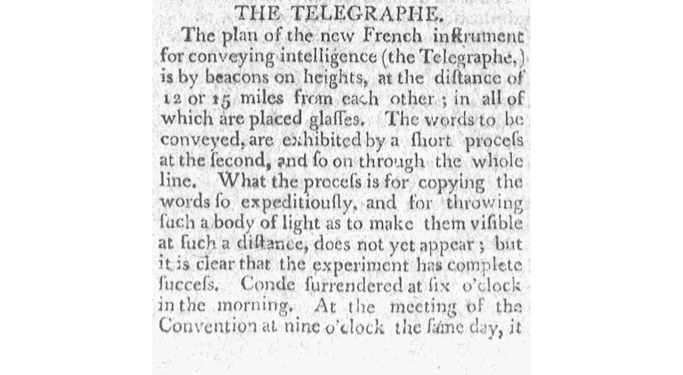
The stations were not meant for public squares, as in the somewhat fanciful context in the rendering above (see Figure 3), but more like the austere passive-voiced reportorial description here (see Figure 4). Indeed, the public should be imagined as a potential decoder in the countryside, waiting passively or aggressively beneath the flow of information, a confusion of unseen seers unable to see—“copying the words so expeditiously, and for throwing such a body of light as to make them visible. . . does not yet appear”. There is not only a deliberate confusion engendered by the encrypted signals, but also a confusion that arises from the non-human agency of transponders—bodies of light and bodies of human copiers are effectively the same.
In fact, that initial puzzlement or wonderment about the grafting of data over demographics was soon turned to distrust of the elitist, undemocratic origins and ends of executive transponders. This disorientation—the national imaginary threatened by encrypted units of time and space, or what Patricia Crain (2003) describes as “paranoia” about the semaphore telegraph’s “seemingly self-authorized power”—is not discernible in any of the early transatlantic accounts (67). But we know that the successor to Chappe’s panel telegraph was destroyed twice by mobs who apparently feared that the telegraph was being used to aid royalist forces within France.
Barely two years later, after the synchronized pendulum and then binary panels, the French had established the first telegraph line, an optical semaphore, that used a four-part armature, the angles of which could be regulated (see Figure 5).
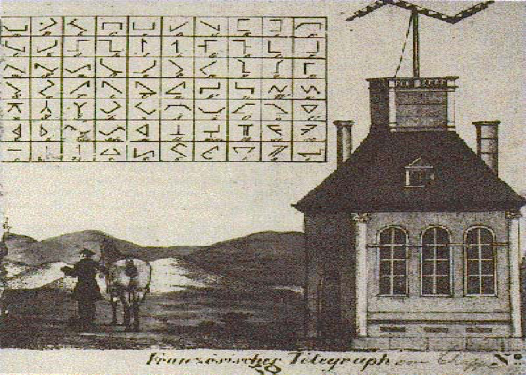
On view here is a muted sociability, with blackened windows in the tower, the crowd absent from a landscape that suggests its utilitarian purpose with diagrammatic rigor. A single man stands with a horse, back to us, presumably part of the postal system, ready to dispatch an end note. The clock face has been replaced by a purely angular semiotics, one whose capacity for coded permutations was multiplied greatly, with sixty-three possibilities. In the armature of the new semaphore, time of transmission is squeezed into smaller intervals, smoothed out and compressed, abbreviation disguised as executive technique. Another way to put it is that executive communication via telegraph was “steganographic,” a term borrowed from diplomatic ciphering’s system for managing confusion. Steganography provided for the polity to be policed and protected via codes.
*
Steganography, the communicative science of secrecy, is one way telegraphy relayed across the Atlantic, before the infamous nineteenth-century story of the heroic laying of the cable. For instance, Benjamin Franklin Bache’s 1797 English-French reprinting of P. R. Wouve’s fragmentary Tableau Syllabique et Steganographique/A Syllabical and Steganographical Table figures encryption as a form of telegraphy, stressing the way steganography guarantees the “safety of the secret” (Wouve 1787, repr.1797).
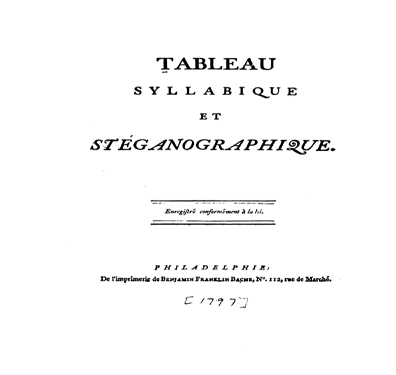
Part of a mini-genre of ciphering and cryptography tables in the 1790s, the manual assembled methods for encrypting information numerically so that it could travel publicly without detection as to alphabetic meaning. As Wouve’s (1787, repr. 1797) manual puts it, “Experience will soon bring to a general demonstration, that the method here employed, is not only conducive to secure the secret of any kind of written intercourse, but is even advantageously applicable to all telegraphical purposes, as well as to all sorts of reconnoitering signals, either for the sea or land service.” The word “telegraphical” here, in its adjectival charge, tropes automatism and brevity, as the republic begins to experiment with abbreviation and secrecy as civic activities.
In 1793, about four months after George Washington delivered the shortest inaugural address in American history (a speech entirely given over to a brief of republican executive caution: depose me if I abuse power), several newspapers reported the demonstration of Chappe’s telegraph as part of a nationalized system. The reportage picked up considerably with news of its instrumentality in the French capture of Conde-sur-L’Escaut from the Austrians in 1794. But rather than the lightning of Napoleonic informatics, telegraphy actually crossed the Atlantic in the slow boat of metaphor, as a second-order signal about easily-relayed public information, rather than a viable state technology of applied steganography. As with other new technologies finding their places within uneven national development, telegraphy and steganography became devices for conceiving a new cultural and political capability, rather than a story about what the device itself does. In the United States, telegraphy became a commercial curiosity inserted into print culture in a way that was either part of an enthusiastic endorsement of, or deep suspicion about, republicanism and its aggressive mutations in Jacobin and early-Napoleonic France. What we notice most is the specter of a technology being used quite openly to ideological ends—republicans praising the possibility of the telegraphic state and Federalists decrying the militarized appropriation of its capacity for public information. Both postures were paranoid, but not entirely unwarranted.
Telegraphy entered the burgeoning print press of the early United States as a metaphor about how dissemination of news across the republic might take place—“telegraphing,” as Barere made clear, keeps information current even at great distances, to the benefit of executive and public alike. In the process of metaphorical transposition, the military was quickly conflated with the political. It joined other technophilic tropes of distance-, time-, or mechanical-conquest in newspapers that incorporated words like “telescope,” “time piece,” “balance,” and “orrery” into their nameplates. This needful over-reach in the naming of newspapers even became the object of satire. On the millennial date of January 1, 1800, the Massachusetts Mercury made sport of the practice of media metaphors in a poem, targeting competitors like The Aurora, The Argus, and The Bee:
That ‘RORA’s’ cloudy, ‘ARGUS’ squints;
That the pert ‘BEE’’s a worthless drone,
Sans sting or honey of his own.
But dropping anger, loud you laugh,
At signal false of ‘TELEGRAPH.’
Despite the manifest epidemic of journalistic over-selling, the telegraphic brand in the US preserved a naïve belief in the transparency of print messaging—it was the same, only faster, and so its use in key parts of the new republic was reassuringly not ambiguous or threatening. As long as it was subsumed within print networks, the telegraph was only indirectly threatening to those who feared republicanism and its radical political agenda derived from revolutionary militancy.
An assortment of rural towns and cities outside the northern periphery had papers that adopted the title. Charleston, SC, was North America’s first. With only four issues of the Telegraph, published from March 16, 1795 to March 20, 1795, and a variant title of The Telegraph and Charleston Daily Advertiser: a proposed Baltimore Telegraphe was advertised in the Aurora General Advertiser in February 1795, but never published. Perhaps the most infamous and influential early “telegraph” (and in many ways an anomaly to the regional and demographic rule at work here) was Boston’s arch-Republican twice weekly, Constitutional Telegraph.[7] Aside from Boston’s Constitutional Telegraph, what one notices is that the majority of “telegraphs” were removed from the metropolitan centers, either in suburbs or frontier towns, across regions north to south, mid-Atlantic to west. Examples include: the Telegraph in Georgetown, KY[8]; the American Telegraphe in Newfield, CT, with a variant of American Telegraphe & Fairfield County Gazette[9]; and Maine’s Wiscasset Telegraph.[10]
The use of the technologized press metaphor tended to be a signal about the party affiliations of the printer, as was the case of Brookfield, Massachusetts’s The Moral and Political Telegraphe.[11] It was produced as a successor to the venerable Isaiah Thomas’s Worcester Intelligencer by Thomas’s apprentice Elisha H. Waldo. Upon taking it over for its run as the Telegraphe, Waldo shifted the paper’s allegiance to republican France, which, as a front-page report of an anti-Jacobin conspiracy put it, had “warm American friends.” There is something fitting about the great printer’s pupil paradigmatically adopting the telegraphic metaphor to politically realign and modernize the news. Allegiance, whether changed or emphasized, moral or political, was publicized by subtle orthographic signals: Boston’s The Constitutional Telegraph changed its spelling to the French in 1802, becoming The Constitutional Telegraphe (see Figures 7 and 8). After the War of 1812, and, arguably, the onset of a Napoleonic executive posture in US political culture, the telegraph secures its place firmly in a variety of nameplates. For instance, the Hillsboro Telegraph[12]; the Columbian Telegraph[13]; the Rochester Telegraph[14]; the Telegraph[15]; and the American Telegraph published in Brownsville, PA.[16]
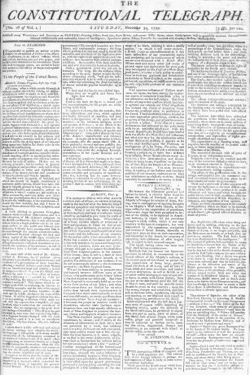
And the Constitutional Telegraphe, three years later transformed with the French spelling and the addition of a flourish of an iconic masthead (see Figure 8):
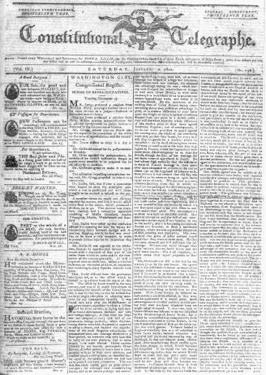
The press motif of a telegraphed republic had a life outside the means of bringing both news and a politicized Napoleonic semiotics to the suburbs and rural outposts of the United States. Indeed its metaphorical purposes did cultural, and even literary, heavy lifting beyond the journalistic. It was both an emblem of progressive inventiveness in pro-French propaganda and a warning about dystopic ruination in Federalist satire. Of the pro-French variety, telegraphy became a glorious artifact and a feature of historical prophecy: Virginia republican St. George Tucker’s 1794 replica model/homage to Chappe’s telegraph was soon after included in Peale’s Museum. And the Aurora/Gazette of 1795 hails the telegraph bringing news at the speed of “lightning” of the “disgrace of our enemies” and the “towering flights of our glories,” positing the conflation of the technology with the triumphantly political. English historian John Gifford produced a grand hagiography called The History of France (1792), praising the telegraph and Napoleon’s military genius that was re-published by the Aurora’s republican printer and editor, William Duane.
Of the latter, anti-Jacobin genre: John Lowell Jr.’s The Antigallican [sic]; or, The Lover of His Own Country: In a Series of Pieces Partly Heretofore Published and Partly New, Wherein French Influence, and False Patriotism, Are Fully and Fairly Displayed,(1797), retails the purported schemes in which Jacobins were wont to use technology to bypass rational debate and aim straight for the passions.
By pompous professions of their own purity, and by an over zealous crimination of their opposers, the Jacobins always aim at exciting the passions of the people, before their understandings have opportunity to examine into the truth. They know that public clamor is like a torrent, which in its destructive course, sweeps away every vestige of human wisdom. . . . By exciting it therefore they hope to overwhelm the monument of law, order and public authority. Thus in the case of the treaty with Great Britain, no arts, no intrigues, no falsehoods were omitted, to excite the prejudice and inflame the passions of the people. . . . They distributed it with the rapidity of the telegraph, and promoted instant discussions of it in illegal assemblies…proud ambition leagued with stupid folly. (32)
Lowell’s “telegraph” is a symbol, part of a political jeremiad meant to appropriately dispose the public to a threat. It is accurate insofar as it presages President James Madison’s rather overt preying on public passions fifteen years later, during the War of 1812. It is also a moment that arguably ushered in the new age of war-making as executive action, when the telegraph’s secretive modalities do indeed feed a politics that is really neither republican nor Federalist, but executive. And while Lowell might have been justified in worrying the Democratic–Republican tilt to France, he need not have fretted the communicative means to that end because the telegraph’s military mode was similarly disdainful of the public and its passions; passions could be political, executive telegraphy was merely strategic.
*
The realization of the telegraph as a militarized national project took some time, but of course it did happen just early enough for the United States to weigh in formally against British anti-Bonapartism. But the actual building of telegraph networks stayed relatively modest in the first decade of the nineteenth century. It is first mentioned as a possible means of “dart[ing] information” in hypothetical land and naval maneuvers in John Dickinson’s 1798 pro-French tract, A Caution: or, Reflections on the Present Contest between France and Great-Britain: “If intelligence from places more remote is wanted, telegraphs can dart it, with any requisite velocity.” Not long after, Jonathan Grant of Belchertown, MA, obtained a patent for an improved semaphore telegraph in 1800 and ran a line between Martha’s Vineyard and Boston (see O’Rielly 1869, 262–69).
In 1813, in the midst of North America’s extension of Napoleonic war, civil engineer Christopher Colles reverse-engineered the telegraphic metaphor and published Description of the Numerical Telegraph for Communicating Unexpected Intelligence by Figures, Letters, Words, and Sentences (see also O’Rielly 1869, 262–69). The word “unexpected” here replays the sense of suddenness and even automatism suggested in Hooke’s plans for a medium that would allow two minds to surpass distance. The condition of war becomes a crystal in the fluid of the saturated medium of political necessity. In the midst of the War of 1812, this is the first attempt to really theorize and diagram a new kind of semaphore telegraph, which would be put to the uses of the American state (see Figure 9). Colles’s plan, first advertised in the Columbian in 1812, was realized in a forty-seven-mile line between New York City and Sandy Hook, NJ.
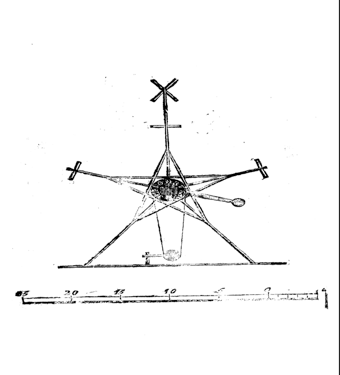
Colles’s semiotic machine was a hybrid of the semaphore, the ratcheting gear, and the clock face, suggesting for the first time a structure not wedded to the land, in the manner of a house, but a mobile, if clunky, device. Moreover, Colles’s telegraph is DIY-modular, and as with the French telegraphic station map it is comically homologous to the human form—a promising stick figure for the execution and administration of post-Enlightenment “unexpected intelligence.” The austere new agent of meaning is fit for Madisonian executive pragmatism—or bumbling, as the case may be. Unlike the French homology of state power, here the telegraphic pattern is coded at a smaller scale, individualized and repurposed for the public sphere of dispersed American political regionalism.
We are learning in the process of historicizing “new media” that nothing is especially new under certain conditions of modernity (see Pingree and Gitelman 2003), and this is particularly true for telegraphy as a medium for political discourse and organized statecraft. The history of the telegraph is far from discretely composed by the period I have chosen to examine in this essay; understanding a range of phenomena—print culture, republicanism, early American regional allegiances—all resolve to greater clarity in the wake of the telegraph’s semiotic migrations. The hardnosed political deployment of the technology in France, the rhetorical circulation of an idea in the absence of state support in the United States, and then the effects of republican executive theory in the galvanizing moment of war—all form a proto-apparatus for militarized communication.
And there is a deeper connection worth following and remembering that has to do with how cultural memory works and how political techniques maintain critical visibility to the public: During the 1790s, the telegraphic metaphor lodged itself within republican print culture benignly and visibly, removed from (but still encoded with) the terms of militarized informatics. That metaphor of telegraphic power emerged as a discernible self-consciousness about the technological shifts and executive ascendancy that began to fundamentally reorder the print sphere and its publics; but that self-consciousness did not extend to shifts in how executive semiotics reordered political life as a function of its form. The early technologists saw all symbol and nation, but not form or the implications of form. Telegraphy is, as such, part of the story of the undoing of the political order of print and the making of something newly invisible both to the public and to itself. Such technology, in which data is joined to politics, communicates its own “natural” ascendancy.
I’d like to thank Sohinee Roy and Christopher Hanlon for their help in preparing this manuscript for publication.
References
Beauchamp, Ken. 2008. A History of Telegraphy. London: Institution of Engineering and Technology.
Cave, Edward. 1794. Gentleman’s Magazine and Historical Chronicle 64, Part 2: 815-16.
Cohen, Matt. 2009. The Networked Wilderness: Communicating in Early New England. Minneapolis: University of Minnesota Press.
Colles, Christopher. 1813. Description of the Numerical Telegraph for Communicating Unexpected Intelligence by Figures, Letters, Words, and Sentences. Brooklyn, NY: Alden Spooner.
Crain, Patricia. 2003. “Children of Media, Children as Media: Optical Telegraphs, Indian Pupils, and Joseph Lancaster’s System for Cultural Replication.” In New Media: 1740–1915, edited by Lisa Gitelman and Geoffrey B. Pingree, 61–90. Cambridge, MA: MIT Press.
Dickinson, John. 1798. A Caution: or, Reflections on the Present Contest between France and Great-Britain. Philadelphia, PA: Benjamin Franklin Bache.
Giedion, Sigfried. 2014. Mechanisation Takes Command: A Contribution to Anonymous History. Minneapolis: University of Minnesota Press. First published 1948.
Gifford, John. 1792. The History of France. London: C. Lowndes and W. Locke.
Holzmann Gerard J. and Björn Pehrson. 2003. The Early History of Data Networks. Hoboken, NJ: Wiley.
Hooke, Robert. 1967. Philosophical Experiments and Observations of the Late Eminent Dr. Robert Hooke. Edited by William Derham. London: Frank Cass and Co.
Innis, Harold A. 1951 The Bias of Communication. Toronto: University of Toronto Press.
Kittler, Friedrich. 2010. Optical Media: Berlin Lectures 1999. Translated by Anthony Enns. Malden, MA: Polity.
Locke, John. 1689. Essay Concerning Human Understanding. Oxford: Oxford University Press.
Lowell Jr., John. 1797. The Antigallican [sic]; or, The Lover of His Own Country: In a Series of Pieces Partly Heretofore Published and Partly New, Wherein French Influence, and False Patriotism, Are Fully and Fairly Displayed. Philadelphia, PA: William Cobbett.
Manovich, Lev. 2001. The Language of New Media. Cambridge: MIT Press.
O’Rielly, Henry. 1869. The Historical Magazine, Notes and Queries Concerning the Antiquities, History, and Biography of America. Vol. V, Second Series. Morrisania, NY: Henry B. Dawson, 1869.
Petre, F. Loraine. 2003. Napoleon and the Archduke Charles. Whitefish, MT: Kessinger.
Pingree, Geoffrey B., and Lisa Gitelman. 2003. “Introduction: What’s New About New Media?” In New Media, 1740–1915, edited by Lisa Gitelman and Geoffrey B. Pingree, xi–xxii. Cambridge, MA: MIT Press.
Wertheimer, Eric. 2012. “Pretexts: Some Thoughts on the Militarization of Print Rationality in the Early Republic.’ Canadian Review of American Studies 42, no. 1: 21–35.
Wouves, P. R. 1787, repr. 1797. Tableau Syllabique et Steganographique/A Syllabical and Steganographical Table. Philadelphia, PA: Benjamin Franklin Bache.
Notes
[1] See Patricia Crain’s (2003) brief but seminal discussion of Napoleon’s message in “Children of Media, Children as Media.” Napoleon’s communiqué of 1799 was not, of course, the first message sent by nationalized telegraph. The very first message came years earlier, in 1794, when Napoleon relayed word of the capture of Quesnoy, an intriguingly precise post-revolutionary report about the surrender of “slaves”: “Austrian garrison of 300 slaves has laid down its arms and surrendered at discretion” (Petre 2003, 65 original emphasis)
[2] Much of my thinking about this set of historically resonant design issues arises from a vein of media theory and history that originates in the work of Harold A. Innis in The Bias of Communication (1951) which begins to connect empire with media history and Sigfried Giedion, whose Mechanisation Takes Command (1948, repr. 2014) articulates a way to think about design as a signifier with deep meaning embedded in social (what he calls “anonymous”) history. I am aware my own terminology here is indebted to the new directions in media history, which take chances with analogies and homologies of form—thus the words “computational” and “binary” in my discussion of the early semaphore telegraph. I view this chance-taking as a way to theorize the semaphore as part of ideologies of representation that are playing out now, in fields like circuit design and social media analysis, but have distinct and identifiable origins in the past. Others in this lineage are of course, Friedrich Kittler (2010) and Lev Manovich, though I am wary of fully agent-less iterations of media history. That wariness is why I am interested in the political figure of the executive within this interpretive and representational network.
[3] No accident it would seem that Napoleon spent part of 1795 in the Department of Topography. It is also worth mentioning that 1795 was also the year he produced the fragments of what would become his novella, Clisson et Eugenie, an example of a remarkably direct style of novelistic narrative.
[4] This is a view of language largely shared by Hooke’s contemporary John Locke in his Essay Concerning Human Understanding (1689); Locke is deeply impatient with the inefficiencies of language as a means to certainty in communication. For further elaborations on the work of Hooke as a key figure in the history of telegraphic representation, see Wertheimer (2012).
[5] Kittler (2010) uses this phrase in referring to Anathasius Kircher’s lanterna magica, pointing out that Kircher developed the projecting device as part of military research (74).
[6] According to Gerard J. Holzmann and Björn Pehrson (2003) in The Early History of Data Networks, the earliest experiments with the concept of the modern telegraph systems occurred in the French navy. Captain Decourrejolles, in 1783, used a coastal network of semaphore stations to transmit enemy positions. In A History of Telegraphy, Ken Beauchamp (2008) has an in-depth description of the development of electrostatic telegraphy, which predated Chappe’s invention, but remained for much of the eighteenth century a parlor spectacle rather than a viable state technology.
[7] Published 276 issues between October 2, 1799 and May 22, 1802.
[8] Published 5 issues between September 25, 1811 and December 22, 1813.
[9] Published 128 issues between April 8, 1795 and December 28, 1796.
[10] Published 41 issues between December 3, 1796 and March 9, 1799, with minor variant titles. It later had the title Lincoln Telegraph, which published 78 issues between April 27, 1820 and October 18, 1821.
[11] Published 67 issues between May 6, 1795 and August 17, 1796.
[12] Published 159 issues between January 1, 1820 and July 13, 1822 in New Hampshire.
[13] Published 11 issues between August 19, 1812 and December 25, 1812 in Norwich, NY.
[14] Published 144 issues between July 7, 1818 and December 26, 1820 in Rochester, NY.
[15] Published 77 issues between January 13, 1813 and July 30, 1814 in Norwich, NY (it was also known as The Telegraph and the Newton Telegraph).
[16] Published 159 issues between November 9, 1814, and March 4, 1818.
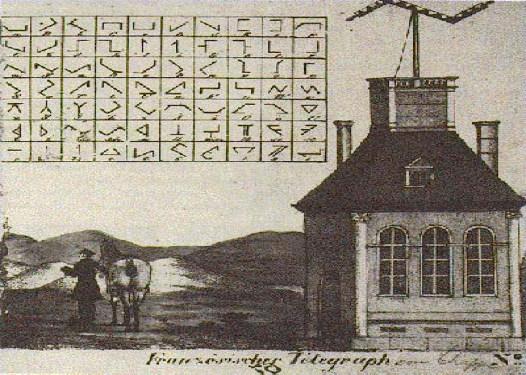
Leave a Reply